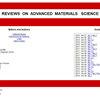Optimizing the performance of TPCB/SCA composite-modified asphalt using improved response surface methodology
IF 3.6
4区 材料科学
Q2 MATERIALS SCIENCE, MULTIDISCIPLINARY
引用次数: 0
Abstract
A composite-modified asphalt was developed by incorporating tire pyrolytic carbon black (TPCB) with a silane coupling agent (SCA) to enhance its ductility and storage stability. The functional binding between asphalt and TPCB was improved by the addition of SCA. The gray correlation comprehensive evaluation method is incorporated into the response surface methodology (RSM), leading to an improved RSM. The improved RSM was employed to optimize the content of the modifier and the preparation process to enhance overall performance. A central composite design-based experiment was conducted to optimize the penetration, softening point, 10°C ductility, Brookfield rotational viscosity, and storage stability indicators of modified asphalt. The response surface of the gray comprehensive evaluation value of the evaluation indicators was calculated using the gray correlation analysis method, and a second-order regression model was established between independent variables such as TPCB, SCA content, and shear time factor and the gray comprehensive evaluation value. This model analyzed the impact of a single variable and variable interaction on the performance of the TPCB/SCA composite-modified asphalt. The optimized model results showed that the preparation parameters that optimize the expected comprehensive performance of the composite-modified asphalt are 9.2% TPCB content, 2.1% SCA content, and a shear time of 56.3 min. Finally, the TPCB/SCA composite-modified asphalt prepared with the improved RSM exhibited the highest gray comprehensive evaluation value and the best overall performance, indicating the feasibility of the optimized preparation parameters with the improved RSM.利用改进的响应面方法优化 TPCB/SCA 复合改性沥青的性能
通过在轮胎热解炭黑(TPCB)中加入硅烷偶联剂(SCA),开发了一种复合改性沥青,以增强其延展性和储存稳定性。添加 SCA 后,沥青与 TPCB 之间的功能性结合得到了改善。将灰色关联综合评价方法纳入响应面方法 (RSM),从而改进了 RSM。改进后的 RSM 用于优化改性剂的含量和制备工艺,以提高整体性能。通过基于中心复合设计的实验,对改性沥青的贯入度、软化点、10°C 延度、Brookfield 旋转粘度和储存稳定性指标进行了优化。采用灰色关联分析方法计算了各评价指标灰色综合评价值的响应面,建立了TPCB、SCA含量、剪切时间因子等自变量与灰色综合评价值之间的二阶回归模型。该模型分析了单一变量和变量交互作用对 TPCB/SCA 复合改性沥青性能的影响。优化模型结果表明,能优化复合改性沥青预期综合性能的制备参数为 TPCB 含量 9.2%、SCA 含量 2.1%、剪切时间 56.3 分钟。最后,采用改进的 RSM 制备的 TPCB/SCA 复合改性沥青的灰度综合评价值最高,综合性能最好,表明采用改进的 RSM 优化制备参数是可行的。
本文章由计算机程序翻译,如有差异,请以英文原文为准。
求助全文
约1分钟内获得全文
求助全文
来源期刊

Reviews on Advanced Materials Science
工程技术-材料科学:综合
CiteScore
5.10
自引率
11.10%
发文量
43
审稿时长
3.5 months
期刊介绍:
Reviews on Advanced Materials Science is a fully peer-reviewed, open access, electronic journal that publishes significant, original and relevant works in the area of theoretical and experimental studies of advanced materials. The journal provides the readers with free, instant, and permanent access to all content worldwide; and the authors with extensive promotion of published articles, long-time preservation, language-correction services, no space constraints and immediate publication.
Reviews on Advanced Materials Science is listed inter alia by Clarivate Analytics (formerly Thomson Reuters) - Current Contents/Physical, Chemical, and Earth Sciences (CC/PC&ES), JCR and SCIE. Our standard policy requires each paper to be reviewed by at least two Referees and the peer-review process is single-blind.
 求助内容:
求助内容: 应助结果提醒方式:
应助结果提醒方式:


